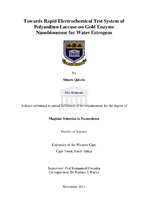| dc.contributor.advisor | Iwuoha, Emmanuel | |
| dc.contributor.advisor | Waryo, Tesfaye T. | |
| dc.contributor.author | Qakala, Sinazo | |
| dc.date.accessioned | 2015-01-29T11:35:27Z | |
| dc.date.available | 2015-01-29T11:35:27Z | |
| dc.date.issued | 2013 | |
| dc.identifier.uri | http://hdl.handle.net/11394/3937 | |
| dc.description | >Magister Scientiae - MSc | en_US |
| dc.description.abstract | Current water treatment technologies do not remove many endocrine disruptor compounds (EDCs) such as 17α-ethynylestradiol (EE2) in its entirety, and the amount of these pollutants that continues to enter the aquatic environment through wastewater effluents is still capable of causing harmful health effects. Therefore the development of simpler and more sensitive biosensor system for detection of EE2 must be developed which have high responsiveness, low cost and easy handling. Therefore the aim of this study was to work towards the development of rapid test system of polyaniline-laccase on gold enzyme nanobiosensor (PANI-PSSA/Lac/Glu) for water estrogens. Preliminary studies were first done on the materials used in this study: estrogens, laccase, gold nanoparticles (AuNPs), and electropolymerized PANI-PSSA. Laccase was shown to be active towards EE2 and the enzyme could be stored for over three months. EE2 solution also could be used for over three
months. Buffer used in this study was found to be suitable. Phosphoric acid (H3PO4) was a suitable electrolyte than hydrochloric acid (HCl) to be used for the electropolymerization of aniline and was used because it has same ions as the McIlvaine buffer (McIlB) which the post-deposition CVs indicated the formation of electrochemically very stable film. AuNPs were successfully synthesized and its size was identified to be less than 22 nm. McIlB used for testing electrochemical properties of AuNP. CVs of GC/PANI-PSSA and GC/PANIPSSA/ Au showed no difference before and after exposure to aq. EE2 solution, an indication of being re-usable and could also serve as stable immobilising platform in laccase biosensor.
When interrogating with electrochemical impedance spectroscopy (EIS), the charge transfer resistance (Rct) of both GC/PANI-PSSA and GC/PANI-PSSA/Lac/Glu showed an average increase by about 2.4% and 21% before and after exposure of EE2, respectively. This shows that the GC/PANI-PSSA/Lac/Glu was a functional EE2 biosensor and showing a positive step towards achieving a re-usable biosensor for EE2 as a model water estrogen. Future work Page | vi will focus on exploring different ways of improving the biosensor’s surface regeneration and its sensitivity to EE2. | en_US |
| dc.language.iso | en | en_US |
| dc.subject | 17α-ethnylestradiol | en_US |
| dc.subject | 17β-estradiol | en_US |
| dc.subject | Estriol | en_US |
| dc.subject | Estrone | en_US |
| dc.subject | Laccase (Trametes versicolor) | en_US |
| dc.subject | Gold nanoparticles | en_US |
| dc.subject | Cyclic voltammetry | en_US |
| dc.subject | Polyaniline | en_US |
| dc.subject | Enzyme biosensor | en_US |
| dc.subject | Endocrine disrupting compounds | en_US |
| dc.title | Towards rapid electrochemical test system of polyanilino-laccase-on-gold enzyme nanobiosensor for water estrogens | en_US |
| dc.rights.holder | University of Western Cape | en_US |

